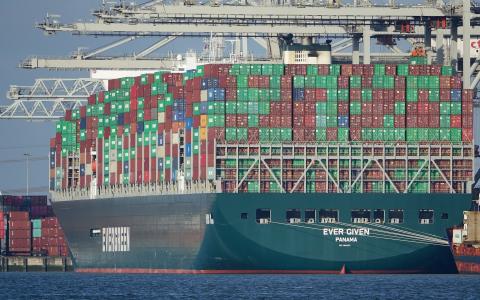
From Rob Williams, chief economist at AAMA, comes yet another great demonstration of the firm's differentiated and actionable take on real-world developments.
A big boat gets stuck in a canal halfway around the world and the price of coffee goes up…

If you haven’t heard, last week brought trouble to the global trade environment when a massive Taiwanese shipping vessel, the Ever Given, became lodged sideways in the Suez Canal. The result is the equivalent of a jack-knifed semi-truck on a busy highway. The only difference is this highway is the main artery for oceanic trade, connecting the Red Sea to the Mediterranean—and by extension the Indian Ocean to the North Atlantic.
To put the importance of this trade route into perspective, an estimated $10 billion worth of consumer goods travels through the canal every day. So in the six days that the Ever Given was stuck the equivalent of Lebanon’s annual GDP was stuck, delayed, or re-routed around the southern coast of Africa.
This colossal, yet unlikely development is called a Black Swan event—a statistical anomaly that should almost never happen. Yet, when they do happen these events tend to make large waves (boat pun intended).
What The Suez Canal Blockage Says About The Global Supply Chain
The Suez Canal blockage (along with the COVID pandemic) shows us just how fragile our global trade system is. Global interdependence is in and of itself risky. Stability in consumer goods supply revolves around international cooperation, and can be affected by anything from “minor” logistical hiccups to deteriorating foreign relationships and war.
And two back-to-back supply chain disruptions (COVID, Suez Canal blockage) demonstrate just how ripe the industry is for innovation.
While we saw a short-term spike in the cost of many consumer goods as a direct result of the Suez Canal blockage, we expect prices to normalize relatively quickly. It’s estimated that the blockage created a 12-week lag in supply chain flow, which is significant, but relatively small in the long run.
The more interesting byproduct will be an evaluation of our global trade infrastructure. We could see increased scrutiny of, and investment in major canals—such as the Suez and Panama.
Unlikely, Yet Obvious
Black Swan events often showcase inefficiencies and vulnerabilities within the systems they disrupt. Another prime example is the 2008 Financial Crisis. Mortgage-backed securities should have been a safe bet, but paired with a lax regulatory environment that allowed banks to profit from housing-related derivative products led to lending to riskier borrowers, and eventually, a collapse in the housing market that rendered a staggering number of bank-owned assets worthless.
At first glance, the 2008 Financial Crisis seemed unlikely. But looking back, in context and with the proper information, the swan looks a little more gray than black.
Construction of the Suez Canal began in 1859. Not only has the world’s engineering prowess advanced considerably, but the size of shipping vessels has also changed dramatically. The Young America was a famous clipper ship built in the 1850s. It was 243 feet long. The Ever Given, which completely clogged the Suez Canal, is 1,312 feet long.
We are driving semi-trucks down a one-lane cobblestone road. While the likelihood of a blockage remains low, it’s not hard to see that this is an entirely possible outcome.
Hindsight is always 2020, but the takeaway here is that Black Swan events that impact economies and markets don’t usually materialize from nothing. This sheds light on the importance of monitoring and managing for macro & contemporary factors, such as geopolitical events and major economic disruptions. At Advanced Asset Management Advisors, macro & contemporary factors are a dedicated piece of our fundamental investment process.
The Suez Canal - A Prime Teaching Moment For Investors
In addition to showcasing the importance of monitoring macro & contemporary factors within your portfolios, the Suez Canal blockage creates an excellent opportunity to demonstrate the importance of downside protection in portfolios.
The blockage was not a high-probability event. Yet it happened and created significant disruptions in global trade. This poses the question, “what happens if a black swan event happens within your portfolio?”.
This could be a great opportunity to break out those Monte Carlo simulations that investors tend to downplay. The Suez Canal blockage could be a prime example of why a 75% confidence rating isn’t enough when preparing for retirement, and why increased savings to account for such events might be wise.
Or what about those clients that get caught up in a strong market and assume too much risk? Black swan events can be powerful reminders that large downturns are possible. And like the Suez Canal and 2008 Financial Crisis, there are factors at play within our market today that would make a downturn look less unlikely than our clients may think.
All in all, while disruptive today, Suez Canal blockage will be nothing more than a blip in the history books. With a resolution found within a week of the incident, we won’t see hyper inflation or other market-altering effects. But what we do see is a clear reminder that unlikely events tend to happen more often than we’d like to think.
They say a failure to plan is a plan to fail. I say we should throw a healthy pinch of cynicism into our financial planning. After all, no one ever complained about being overly prepared for retirement!



